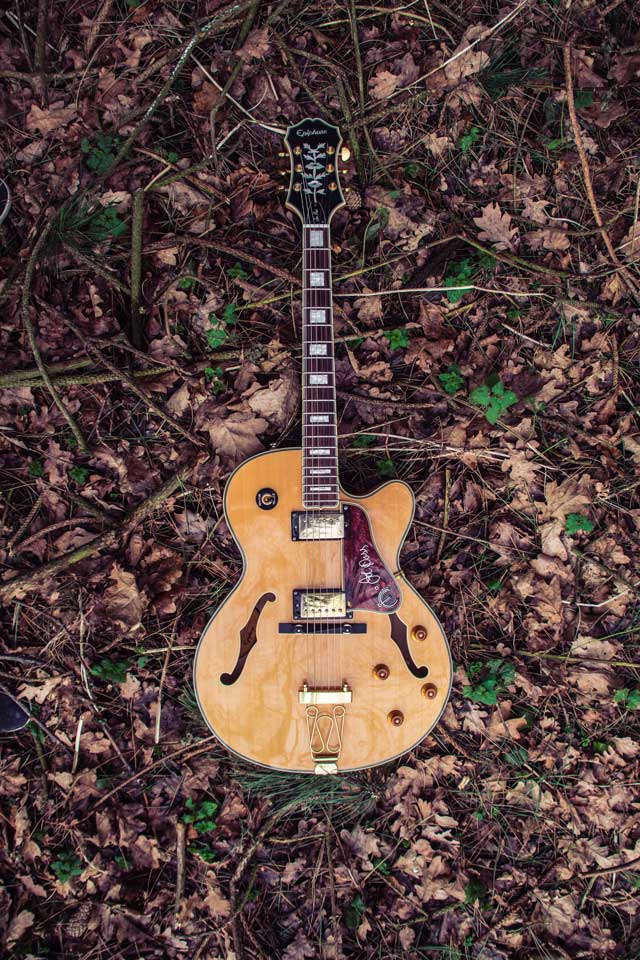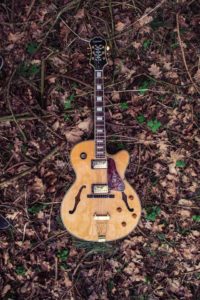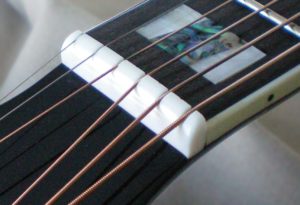Why Humidity Matters to Your Guitar
We’re probably too caught up in our music to worry about humidity levels. But here’s the deal: guitars are crafted using delicate materials, like wood, metal, and glue. These materials are sensitive to changes in humidity, affecting your guitar’s playability, sound quality, and overall lifespan.
The Hidden Danger of High Humidity
Imagine jamming on a hot, humid summer day – your guitar might be in danger! High humidity can lead to:
- Swollen Wood: When the air gets too humid, your guitar’s wood can soak up all that moisture like a sponge. This makes the wood expand and grow bigger. Yikes! Your guitar’s neck might bend, and the strings could get higher, making it challenging to play your favorite tunes.
- Annoying Fret Buzz: You know that annoying buzzing sound when you play? Blame the humidity! When the neck swells, it pushes the strings too close to the metal frets. Buzz, buzz, buzz! It’s like a tiny insect party on your guitar!
- Ugly Finish Damage: Uh-oh, high humidity can also be a disaster for your guitar’s looks! The varnish on your guitar can turn sticky, crack, or even peel off. Oh no, say goodbye to that sleek and shiny look!
- Nasty Mold and Mildew: Humid places are like a playground for mold and mildew. They love to grow on your guitar, making it look and sound terrible. Your beautiful guitar can turn into a moldy mess!
The Perils of Low Humidity
On the other hand, during dry winters or in arid regions, low humidity is the culprit. It leads to:
Shrunken Wood: Dry conditions cause the wood to shrink, inviting cracks and separations in your guitar’s body. As the air lacks moisture, the delicate wood of your guitar starts to lose its natural moisture content. This leads to the wood contracting and shrinking, putting immense stress on the instrument’s structural integrity. The consequences can be seen in the form of cracks and separations on the body, fretboard, and neck. The haunting sight of these blemishes can strike a chord of distress in the hearts of guitarists.
Uncomfortable Fret Ends: The sharp ends of frets might extend beyond the fretboard’s edges, making your hands ache during play. The frets, those tiny yet essential metal strips along the fretboard, are not spared from the effects of low humidity. As the wood contracts, the fretboard’s edges become exposed, causing the fret ends to protrude. This not only causes discomfort to your hands during play but can also lead to painful nicks and cuts. Such a revelation surely calls for timely action to prevent the discomfort from escalating.
Dreadful String Buzz: The neck might straighten or back bow due to low humidity, leading to annoying string buzz and decreased playability. The neck of your guitar can also suffer during periods of low humidity. The reduced moisture content can cause the neck to straighten or develop a back bow. As a result, the strings may come dangerously close to the frets, causing that dreaded string buzz. The loss of playability and the irritating buzz during your tunes can be a disheartening revelation for any guitarist.
Structural Damage: Extreme dryness can weaken glue joints, resulting in structural issues that could break your heart and your wallet. The glue joints that hold the various components of your guitar together can weaken under the influence of low humidity. Over time, this can lead to structural damage, leaving you with a disheartening discovery that could break not just your guitar but also your heart. Avoiding heartbreak calls for vigilance in maintaining the ideal humidity level for your instrument.
Keeping the Perfect Humidity Level
We get it; adulting is hard, and who has time to worry about humidity levels? Fear not, because it’s easier than you think to protect your guitar:
Hydration is Key: Get a guitar humidifier to release moisture into your guitar during dry times. Think of it as your guitar’s water bottle!
Say No to Sun and Heat: Keep your guitar away from direct sunlight and heat sources to avoid dramatic humidity fluctuations.
Hygrometer – Your Humidity Detective: Invest in a hygrometer to monitor humidity levels in your guitar’s storage area. Be a detective, not a victim!
Conclusion
As young musicians, we may prioritize rocking out over worrying about humidity. But protecting our guitars is crucial for uninterrupted jam sessions and preserving our musical investments. With a little knowledge and care, we can ensure our guitars stay in top-notch shape, ready to unleash our creativity whenever inspiration strikes. So, let’s embrace this newfound awareness and show our guitars the love they deserve – because together, we’ll create music that resonates with our souls and the world. Happy playing!




